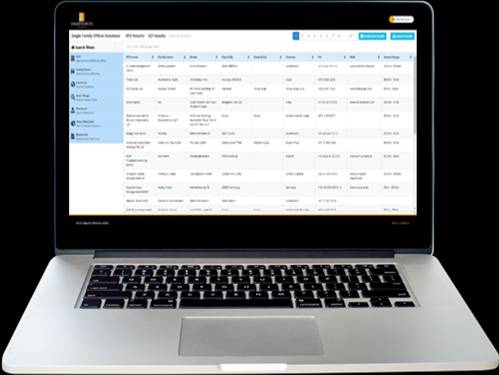Family Office
Single Family Offices - Who Knows The Numbers?

This article addresses the difficult subject of estimating the actual number and size of single family offices around the world. It is written by the founder of Highworth, with which this news service has an exclusive media partnership.
The marketplace of single family offices fascinates not least because precise data on these organisations can be tough to find. That does not stop certain groups from making claims about the size and extent of SFOs today.
One of this news service’s sister publications, WealthBriefing, has recently formed an exclusive media agreement with Highworth, which compiles considerable data on SFOs – their assets under management, investments, geographic locations and structures – and we consider that it adds vital information, particularly on SFOs outside North America, which tends to be more extensively covered. (See an example of Highworth insights here.)
Following some recent claims about the size of the sector, here are comments from Highworth founder Alastair Graham and we hope readers in North America, and other regions, find these useful to get a sense of some of the measurement issues. To register on the Highworth database for a trial, see here.
And of course, for those who want to contact the editor about this or other stories, get in touch at tom.burroughes@wealthbriefing.com.
Single family offices have probably been the fastest growing segment of the wealth management industry since the financial crisis of 2008. However, SFOs are reclusive, preferring anonymity, with many having good reason to fly under the radar. Yet increasing interest in the sector has encouraged pundits to come forward with bold and confident calculations of their numbers. Some of these assessments have a precision, however, which should be challenged.
In 2016 EY estimated that there were 10,000 SFOs globally. Last week Campden estimated there were 7,300, and that the number had grown by 38 per cent in the past two years. The confidence with which these exact numbers are presented invites scepticism for the simple reason that the hard core data on which such assessments should be based, does not yet exist.
The calculation of uncertainty
Donald Rumsfeld, the US Secretary of Defence, was initially
mocked back in 2002 when he cryptically commented in a NATO
briefing: “There are known unknowns. There are things that we now
know we don’t know. But there are also unknown unknowns. There
are things we do not know we don’t know.” Single family offices
fit well into this structure, of course a commonplace for many
types of research process whether economic or scientific.
The Single Family Offices Database from Wealthbriefing and Highworth Research, the largest online database of SFOs available, currently holds, both online and in reserve, some 1,400 SFOs in 61 countries outside the US, with an additional 800 held for the US. Knowledge of the multiple sources of the data allows the researchers to be confident that the non-US number will rise to an identified and profiled 2,000 outside the US and approximately the same number within. Therefore the Wealthbriefing-Highworth Research partnership knows that there are 4,000 SFOs globally which can be identified and reached.
From this number the research team can reasonably project that there may be about 2,000 further SFOs that we don’t yet know about. These could be said to be the known unknowns, factors which can reasonably be anticipated but not precisely quantified.
The “unknown unknowns”
But that is not the end of the matter. A preference for secrecy,
security, aversion to the taxman, and other constraints create an
environment where further single family offices are likely to
exist but we have no certainty of the numbers and any number will
be a surprise. In Rumsfeld-speak, they represent the unknown
unknowns. There may be up to another 2,000 globally but nobody
really knows. So be suspicious of claims of precision when it
comes to sizing the SFO market, or of claims for exact percentage
growth from one year to the next.
SFO assets under management
Each SFO on the Wealthbriefing-Highworth SFO Database is
assigned to one of ten AuM ranges, staring with $10m to $50m and
finishing with over $15 billion. The assignment is not
speculative but based on an assessment of the evidence available
for each SFO. The most populated are in the $500 million to $1
billion, and $1 billion to $2.5 billion ranges. Aggregating the
AuM of all 1,100 SFOs which will be on the database in 2019 at
the lower point of the 10 ranges indicates total AuM of $1.57
trillion, while at the higher end of each range indicates total
AuM of $2.45 trillion. At the median point of the 10 ranges, the
aggregate AuM is $2.01 trillion. This is a conservative figure
because it is calculated on the basis that the 30 or so SFOs with
AuM of over $15 billion hold only $15 billion each whereas the
majority of these hold higher sums and several, much higher. The
final total for the 1,100 SFOs is more likely to be close to $2.2
trillion.
SFOs’ assets compare well with institutions
It should also be noted that this is the aggregate AuM in 2019 of
1,100 SFOs located outside the US.
If there are indeed about 6,000 SFOs globally at present which are known, or are known unknowns, on a simple extrapolation basis, the total indicative AuM would be $11.95trillion. If you venture into the speculative assessment of the unknown unknowns, the number could rise to around $16 trillion. By comparison, according to Willis Towers Watson’s calculations, in 2017 institutional asset owners globally controlled $131 trillion, of which pension funds, for example, represented $45 trillion and insurance funds $33 trillion.
In this context, SFOs represent a compelling target for private banks and asset managers.